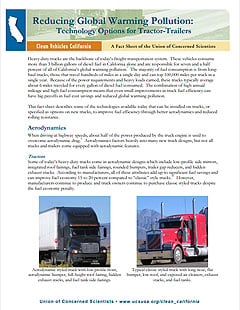Heavy-duty trucks are the backbone of today’s freight transportation system. These vehicles consume more than 3 billion gallons of diesel fuel in California alone and are responsible for seven and a half percent of all of California’s global warming pollution. (1) The majority of fuel consumption is from long-haul trucks, those that travel hundreds of miles in a single day and can top 100,000 miles per truck in a single year. Because of the power requirements and heavy loads carried, these trucks typically average about 6 miles traveled for every gallon of diesel fuel consumed. The combination of high annual mileage and high fuel consumption means that even small improvements in truck fuel efficiency can have big payoffs in fuel cost savings and reduced global warming pollution.
This fact sheet describes some of the technologies available today that can be installed on trucks, or specified as options on new trucks, to improve fuel efficiency through better aerodynamics and reduced rolling resistance.
Aerodynamics
When driving at highway speeds, about half of the power produced by the truck engine is used to overcome aerodynamic drag. (2) Aerodynamics factors heavily into many new truck designs, but not all trucks and trailers come equipped with aerodynamic features.
Tractors
Some of today’s heavy-duty trucks come in aerodynamic designs which include low-profile side mirrors, integrated roof fairings, fuel tank side fairings, rounded bumpers, trailer gap reducers, and hidden exhaust stacks. According to manufacturers, all of these attributes add up to significant fuel savings and can improve fuel economy 15 to 20 percent compared to “classic” style trucks.(3) However, manufacturers continue to produce and truck owners continue to purchase classic styled trucks despite the fuel economy penalty.
Trailers
More than 65 percent of the miles traveled by heavy-duty combination tractor-trailer trucks occur with box van trailers.(4) The basic rectangular shape of the van trailer offers significant opportunities for improving the aerodynamics and fuel efficiency of the tractor-trailer combination. The technologies shown below are designed to reduce turbulent air flow in the front of the trailer (in between the gap of the tractor-trailer), the underside (between the rear tractor tires and the rear trailer tires), and the rear (behind the rear doors).
A combination of these trailer technologies, along with low-rolling resistance or single wide tires described below, can improve overall tractor-trailer fuel efficiency by am additional 10 percent or more.(5)
Rolling resistance
Besides decreasing aerodynamic drag, reducing the rolling resistance of heavy-duty truck tires can also help improve fuel efficiency. The friction between the rolling tire and ground, or rolling resistance, can be impacted by the design, materials, and the level of air pressure of the tire. Between 15 to 33 percent of heavy-duty truck fuel consumption is used to overcome rolling resistance.(6) Described below are ways truck owners can reduce rolling resistance and improve fuel efficiency.
Low rolling resistance tires
The materials and design of a tire influence the rolling resistance characteristics. The US Environmental Protection Agency’s (EPA) SmartWay program identifies tire models that have the lowest rolling resistance and offer the best fuel economy improvements. Truck tires are typically retreaded when they wear out, as opposed to completely replacing them. For this reason, it is important to ensure that tires which are retreaded meet the same standards for rolling resistance as the original tire.
Single wide tires
The most common configuration for tractor-trailers is to have dual (side-by-side) tires on each axle, except for the steering tires in front. Single wide tires are designed to replace each set of dual tires with one extra wide “super single” tire. Super singles offer both aerodynamic benefits as well as improved rolling resistance. Super singles also offer weight reduction advantages, as the super single tire and rim weigh less than the two tires and rims that they are replacing. Aluminum rims can also be utilized to further reduce weight. Reducing weight offers improved fuel efficiency, or alternatively, allows a heavy load to be carried while continuing to meet highway weight restrictions.
Auto tire inflation systems
Keeping tire pressures maintained on heavy-duty trucks is important for maximizing fuel efficiency, tire wear, and safety. Auto tire inflation systems help to maintain the proper inflation levels at all times, rather than only during periodic maintenance checks. The EPA estimates that a 0.6 percent gain in fuel efficiency can be realized with these systems.(7) Greater improvements will be realized from auto tire inflation systems for fleets that currently do not frequently maintain tire inflation levels.
Purchasing new trucks, or retrofitting existing trucks, with aerodynamic features and low rolling resistance tires can significantly improve the fuel economy of heavy-duty trucks, save truckers money at the diesel pump, and reduce global warming emissions. Manufacturers of tractors and trailers can now certify their products under EPA’s SmartWay program if they meet specific performance criteria for air pollutant emissions and fuel efficiency. This program will help truck owners identify both new equipment and retrofit devices that can help them reduce global warming pollution and save fuel.
There are also additional strategies that can improve the fuel efficiency of today’s heavy-duty trucks, including improved logistics systems, more efficient engine and drive trains that include hybrids, lighter weight materials, lower carbon fuels, reduced highway speeds, elimination of idling, and improved driver training. A combination of these strategies will lead to the greatest reduction in global warming pollution from heavy trucks.
Sources
-
California Energy Commission, Inventory of California Greenhouse Gases Emissions and Sinks 1990 to 2004, December 2006.
-
US Department Of Energy, Technology Roadmap for the 21st Century Truck: A Government-Industry Research Partnership, December 2000, page 4-2.
-
Peterbilt’s Fuel Efficiency and Aerodynamics brochure indicates a 15 percent fuel economy improvement over a classic styled truck. (www.peterbilt.com/pdf/AeroReturns.pdf accessed 10/16/2007) Kenworth’s Push Less Air Pull More Profit: A Guide to Increasing Fuel Economy indicates up to a 20 percent improvement over a classic styled truck with no aerodynamic devices. (http://www.kenworth.com/brochures/FuelEfficiency.pdf accessed 10/16/2007).
-
Based on survey data collected by the US Census Bureau in the 2002 Vehicle In-Use Survey for class 7 and 8 combination trucks.
-
According to EPA the combination of single wide tires and trailer side skirts can improve overall tractor-trailer efficiency by 8 percent. See website http://www.epa.gov/smartway/calculator/loancalc.htm. An analysis by the California Air Resources Board finds that a combination of trailer aerodynamics, single wide tires and wheels and automatic tire inflation can improve fuel economy by 13.9 percent. See California Air Resources Board, Expanded List Of Early Action Measures To Reduce Greenhouse Gas Emissions In California Recommended For Board Consideration, October 2007, pages B-17 through B-20. Similar results have been shown in independent track testing. See Bachman, Joseph L., et al., Effect of Single Wide Tires and Trailer Aerodynamics on Fuel Economy and NOx emissions of Class 8 Line-Haul Tractor-Trailers, SAE Paper Number 05CV-45, 2005.
-
US Department Of Energy, Technology Roadmap for the 21st Century Truck: A Government-Industry Research Partnership, December 2000, page 4-8. Range represents regional and line haul applications.
-
According to EPA. See website http://www.epa.gov/smartway/calculator/loancalc.htm




